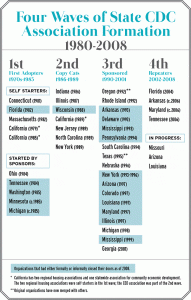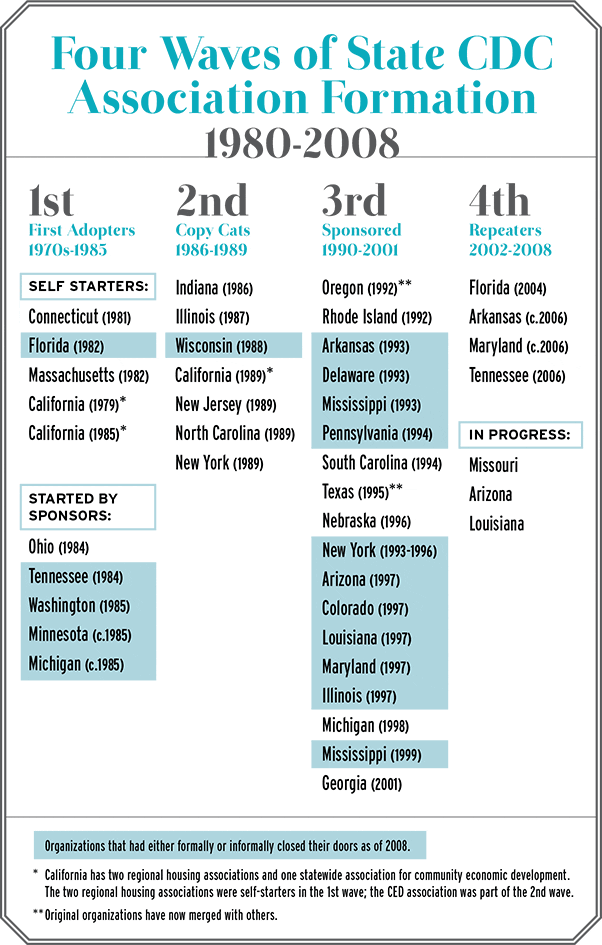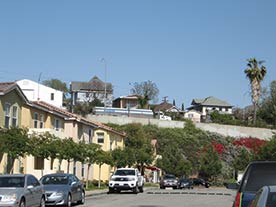
These state CDC associations have been formulating policy positions, offering training and technical assistance to their CDC membership, advising governors, legislatures, and state agency staff, and joining cross-sector partnerships to influence policy for more than three decades, but we have little systematic knowledge about them. More specifically, we don’t know why some associations have lasted over time and others haven’t, and what could improve their sustainability. This is important for existing CDC associations and their members, as well as those CDCs considering or in the process of forming an association, to understand in order to strategize for improved sustainability and effectiveness.
To reconstruct the history of the growth of state CDC associations, I analyzed documents from the former National Congress of Community Economic Development (NCCED) and from existing associations, whom I also surveyed online and conducted interviews with in 2008 and 2009. From this information, I identified four distinctive waves of network formation as well as some factors and recommendations for successful sustainability.
Four Waves of Formation
There have been four waves of association formation (see table). The associations within the first wave were formed from the 1970s through 1985. These included two distinct subgroups: one group of bottom-up self-starters (Connecticut, Florida, Massachusetts, and California), and another group that was targeted for initial funding and technical assistance by NCCED through an Economic Development Administration grant (Ohio, Tennessee, Washington, Minnesota, and Michigan).
This was followed by a rapid, second wave of associations formed to capitalize on the emerging success of the first wave by replicating their strategies. These organizations received assistance from NCCED, but NCCED was not necessarily the initiator. There is also evidence that these newer organizations were actively networking with and learning from the directors of the first-wave associations.
A third wave of formation took place from 1990 to 2001, during which state associations were heavily promoted through start-up funding to an additional 16 states, plus two second attempts in states that had previously hosted an unsuccessful organization. These were years of strong Ford Foundation and other pass-through funding through NCCED. At least 18 of the roughly 29 associations in existence during this period received at least a planning grant from NCCED, if not actual operating support to help get them started.
A fourth wave extends from 2002 until the present. All of the associations in this wave are a second attempt within a state where a prior organization failed. A national intermediary, the Local Initiative Support Corporation (LISC), has been especially active in recent years with attempts to reestablish state or regional associations within states where previous associations have failed, such as Florida, Arizona, and Missouri.
Success Rates and Factors
Of the first wave, many more self-starters are still in existence (75 percent) than those that were targeted by a patron for support (20 percent). Second-wave copycats, who were following their own initiative and learning from peers are mostly still around (83 percent), but most of the organizations assisted in the third wave with pass-through patron funds failed (only 33 percent still in existence, even though they were started more recently). This might indicate a failure to gain local grassroots support or insufficient human and financial capital needed to sustain the organizations. It could also indicate that these states have weaker CDC industries and political support. In some cases (NY, PA, IL), a strong organization working on similar issues already existed, and competition for scarce resources quickly rooted out redundancies. It’s too soon to make assessments about the success rates of the fourth wave.
It seems that certain catalysts and environments have been more likely to lead to the success and sustainability of state CDC associations than others. Financial or in-kind sponsors such as NCCED or university departments or centers helped catalyze many associations, but were unable to sustain them in the long run. Those organizations that have lasted identify bottom-up CDC mobilization as a very important catalyst, along with the work of particular entrepreneurial leaders.
In addition to how the association formed, internal capacities and external conditions set the stage for success or failure. Internally, adequate human and financial resources are key components to an organization’s survival. The number of employed staff has crept up from barely 1 full-time staff in the 1980s to an average of 5 paid staff in 2008, and at least a half-dozen associations have had the same executive director for 10 years or more, with several directors nearing or surpassing two decades of leadership.
State association budgets have diversified and expanded over time, shifting away from reliance on philanthropic and corporate donors and earning more public sector grants and contracts. Government funding has grown as a proportion of state CDC association budgets over the years, perhaps indicating a renewed willingness on behalf of government to support these organizations. Public sector partners also seem to recognize the value of having a unified voice speaking on behalf of CDCs when it comes to gaining input on state policies and programs.
Challenges and Recommendations
Formation through bottom-up organizing and sustained member participation is critical to sustaining state CDC associations in the long run. Seed funding and a few interested partners are not enough. This can be challenging in states with few or widely-dispersed CDCs.
State political support for community-based nonprofit housing and community development activities is critical. In general, today’s state CDC associations find state political support for CDCs to be neutral on average, regardless of how long the association has been around, how big it is, or how much funding it has. Half find their state to be at least somewhat supportive, while the other half indicated a somewhat to extremely unsupportive environment. However, there is hope in sustaining relationships with the administrative agencies most supportive of CDCs, such as housing and/or community development departments, housing finance agencies, and economic development agencies. In addition, strengthening weak connections with departments focused on related policy areas could be opportunities for state CDC associations. These include areas such as commerce, labor, health & human services, aging, children and families, veterans’ affairs, and public safety.
Partnerships are more important than ever. All but one state CDC association responding to the 2008 survey indicated that they were members of other networks addressing housing and community economic development issues. These included coalitions addressing homelessness, supportive housing, poverty alleviation, small businesses, and community reinvestment. Almost two-thirds of state CDC associations have also formed multi-interest housing campaigns (MIHCs) with partners from the nonprofit and private sectors to raise public awareness about housing needs. Most MIHCs report success in raising awareness, and a few report new legislation and funds as a result of their efforts.
Drawing from these findings, I suggest that CDCs looking to form or sustain state CDC associations should focus their attention on:
- Organizing and mobilizing a strong, core CDC membership.
- Advocating their value to the public sector, especially key administrative agencies, to garner increased political will and funding.
- Partnering with others around common interests to increase their voice, legitimacy, and wins for CDCs.
- Diversifying their funding, without letting funding set their agenda.






Follow me on Twitter at @CorianneScally and join my list on CDC Associations to follow current state and local CDC associations.
The National Alliance of Community Economic Development Associations (NACEDA), is the trade association for almost all the associations listed. We produced a pretty thorough state association portrait/report (membership diversity, programming, budgets, etc.) in 2011 (see link below) and are planning for an update in 2014. We also sit on the Shelterforce Advisory Committee.
Our 7th annual summit will be held in Detroit in the first week of October, 2013. There should plenty of opportunities to get more updated information than 2008/9.
NACEDA was founded in 2007 by state associations seeking a national alliance. I am most impressed the state associations have been able to form and support a national alliance during one of the most challenging funding/economic environments for non-profits (and associations generally) in our lifetimes. For that, all the associations big and small need to be commended. As association professionals they intuitively know the value brought by their peers. As community development has received criticism, the state associations have been rocks and anchors for those practitioners serving neighborhoods and people.
https://naceda.org/sites/default/files/Member Survey – For NYC Trip 2011-11-28.pdf
NACEDA was one of the earliest supporters of this research (I presented initial findings at your 2009 annual conference), which was the first census of state associations since NCCED folded. I am glad to hear of your growing strength and continuing work, and continue to follow and support the work of your members with great interest (and am speaking at one of their statewide conferences coming up, in fact, on university-community collaborations). Do let me know if I can be of help with any of your future efforts. Thanks for the update!